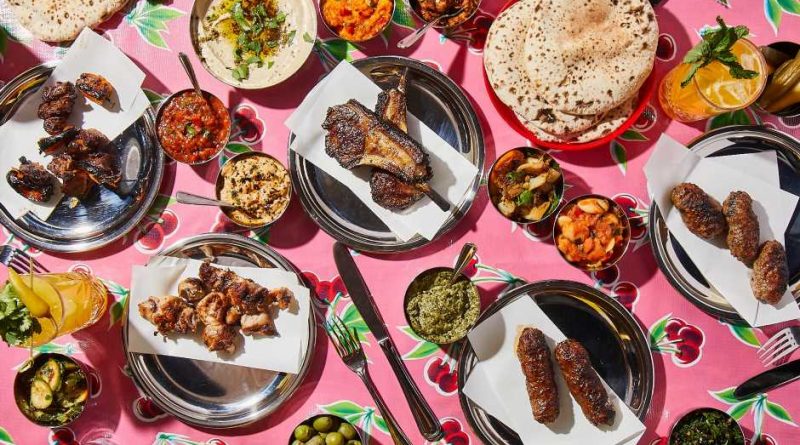The Best New Restaurants in the World: 2021 Hot List
This year’s annual Hot List of the best new hotels from around the world is a story of resilience. Despite enormous hardship in the travel industry, exceptional properties have continued to open across the globe (nearly a thousand last year in the U.S. alone). As always with this endeavor, each of the 69 picks on this year’s list was safely vetted by our international network of correspondents. But as we’ve learned in the past year, everything is connected, which is why we’ve also expanded the scope of hot to include restaurants, transportation, and destinations, as well as more news we’re excited about set for later this year. In spite of it all, these new restaurants are a success story all their own. We think they’re a pretty great way to mark the 25th anniversary of this list.
Click here to see the entire Hot List for 2021.
Cat-Su Sando, Chicago
A pandemic pivot for Chicago alums of fine-dining restaurants Saison, Blackbird, and Oriole, Cat-Su began out of a cloud kitchen last fall and has since opened a storefront in the Humboldt Park neighborhood. On the evolving menu—ramen and home-brewed kombucha were just added—you’ll find American takes on Japanese sandwiches and snacks like kushiyaki (grilled meat-and-veggie skewers), Spam musabi, and gyoza. Order one of everything and share. Then order one more of the namesake dish, the Cat-Su Sando, a fried chicken thigh with cabbage and special tonkatsu sauce on milk bread, to eat later all by yourself. — Madison Flager
Red Rooster Overtown, Miami
Chef and restaurateur Marcus Samuelsson’s second U.S. Red Rooster location follows the elevated comfort food lead of the Harlem original but with some Magic City sparkle. The design pays tribute to this historically Black, Latino, and Caribbean neighborhood, from framed pages from The Negro Motorist Green Book on its walls to the patio space built around the 30-foot-tall tamarind tree that’s been a community landmark for decades. Even the famous yardbird fried chicken gets a Miami welcome with a tropical sour-orange honey sauce. Let the sunshine vibes reign. — Nila Do Simon
Happy Paradise, Hong Kong
After launching Little Bao in Hong Kong in 2013, chef and LGBTQ-rights activist May Wong scooped up award after award. Now she has created a similarly cool Cantonese outpost in the heart of Central that pays homage to Hong Kong’s unique identity. The decor—part Wong Kar Wai film, part cyberpunk video game—features tong lau (tenement) tiles, vinyl booths, and candy-colored neon lights. And then there’s the menu, which takes the humble egg waffle, found on almost every street corner in town, and turns it into a near-transcendent experience. Favorites like the seared skirt steak, served with fat tubes of silky rice noodles plumped with strips of Australian wagyu and hits of seaweed butter, pull in the crowds, as do excellent cocktails like the five-spice gin and tonic, served in a goblet and decorated with a pink paper flamingo. — Lee Cobaj
The Mayfair Supper Club, Las Vegas
Pity the stiffs who go to Las Vegas and think they’re above a little spectacle. That’s the point, right? Edging the casino at the Bellagio, the Mayfair is a sumptuous throwback to the supper clubs of yore—with fringe and feathers flying in every direction, seafood towers wheeled past saucer-eyed diners cocooned in scalloped banquettes, and sequined chanteuses lighting up the stage like it’s the Roaring Twenties.The performance turns progressively more lascivious as the night wears on; guests may, too, if they’ve been tipping back martinis at the nautical-themed bar. Such top-flight showmanship, which draws the glittery likes of Lady Gaga, might feel empty if the Mayfair’s food weren’t also extraordinary, but the restaurant is the whole package. That all this calculated flamboyance takes place with the Bellagio’s famous fountains leapfrogging just beyond the arched windows is almost too much—and also the most Vegas thing ever. — Ashlea Halpern
Boxer, Auckland, New Zealand
At first glance, Boxer might seem like a charcoal-walled shrine to minimalism, but don’t be fooled. The latest from Auckland chef Ed Verner (the man behind the city’s acclaimed restaurant Pasture) ripples with a theatrical energy that doesn’t just push boundaries, it erases them. Inspired by “listening bars” in Japan, the 11-seat drinking den centers around a retro vinyl player that blasts Wu-Tang Clan or AC/DC as guests perch at two oversized wooden counters. There are no spirits, only distillates, and the only wine here has been doctored, extracted, and transmogrified into umami-packed cocktails. The kaiseki-style food menu is as imaginative as the drinks, from the pork-fat pretzels served with matcha cultured cream and salmon roe to the sashimi from a line-caught moon fish cut in front of you. With so many action-packed details, even the most traditionalist shaken-not-stirred guests will joyously geek out. — Chloe Sachdev
Communion, Seattle
The roots run deep at chef Kristi Brown’s Central District restaurant, from her decades of catering in Seattle to the physical location in the city’s historically Black neighborhood, on the site of the Pacific Northwest’s first Black-owned bank. Brown established herself on the city’s food scene as a soul food master long before chef Edouardo Jordan’s JuneBaby arrived; now her first restaurant is bringing her signature black-eyed-pea hummus to the masses. The menu also nods to Seattle’s Asian and East African communities with dishes like the fried catfish po’mi—po boy meets banh mi. Even though Brown and her co-owner, son Damon Bomar, opened during a pandemic, the duo dared to build an eatery around a communal table—a sign of their confidence in their mixing-pot ethos. — Allison Williams
Miro Kaimuki, Honolulu
The exterior is so discreet that it’s a feat to locate the door. But once you’re inside and settled at one of the blond-wood booths sipping a cocktail of smoky Japanese whiskey infused with black honey, you’ll feel like one of the initiated. Just try to play it cool when a puffy disc of sourdough arrives with salted butter and za’atar. Led by chef Chris Kajioka, a James Beard nominee and Honolulu native, the restaurant offers a fixed five-course menu that changes monthly: on one visit, a slab of perfectly pink flank steak with chard; on another, salmon with crispy quinoa. And the meal always ends with a fairy-tale dessert, like matcha-passion-fruit cake. — Alex Erdekian
Chifa, Los Angeles
This restaurant-slash-showroom in the Eagle Rock neighborhood is pure Hollywood Regency glam: velvet chairs, zebra-print wallpaper, and playful ceramics, much of which is available for purchase. In the early days of its existence, you could almost feel the stylized space longing for the return of in-person dining to bring it fully to life. Dinner service at this Peruvian-Chinese spot has been drawing diners at a steady clip to its patio for chicha morada and mapo tofu. Humberto Leon, the cofounder of cult brand Opening Ceremony, partnered with his sister Ricardina and her husband, John Liu, bringing back some of their mother Wendy’s recipes from the time when she owned a restaurant in Lima. Dishes, including Wendy’s signature Cantonese soy sauce chicken and a take on her char siu pork, smash any suggestion that Chifa values flair over flavor, while making the whole endeavor a true family affair. — Krista Simmons
Cozy Royale, New York City
When someone asks what they should eat in New York City, pickled bologna is rarely the response. But that was one of the early standouts at Cozy Royale in Brooklyn, the first full-service restaurant from the brains, soul, and knife-wielding hands behind the beloved Williamsburg butcher shop the Meat Hook. The debut menu riffed on Appalachian food, a rarity outside the region (hence the pickled bologna), as well as the finest version of a pepperoni roll you can find. — Noah Kaufman
Culinarium Alpinum, Stans, Switzerland
Switzerland has a reputation for mile-high expense account dining, but this new Alpine culinary center, housed in a 16th-century Capuchin monastery 25 minutes from Lucerne, provides a more accurate picture of the country’s hardscrabble mountain past. It promotes heritage and heirloom fruits and vegetables you won’t see on menus at palace hotels or ski resorts. The center opened last September with the aim of forging better relationships between Swiss chefs and local farmers, and its workshops cover everything from bratwurst-making to schnapps tastings. The in-house restaurant serves dishes like whitefish from Lake Lucerne coated in local walnuts at tables that spill out into an “edible landscape” where 500 rare fruits grow, while a guesthouse offers 14 rooms in refurbished monks’ cells. Make sure there’s space in your luggage for provisions from its klosterladen (cloister shop), which specializes in the bounty of central Switzerland, including Alpine milk caramels, wheels of aged Sbrinz cheese, and quince liquor. — Adam H. Graham
Laser Wolf, Philadelphia
In the classic musical Fiddler on the Roof, Lazar Wolf is the haughty village butcher with designs on marrying Tevye’s eldest daughter. Culinary impresarios Steven Cook and Michael Solomonov isolated the meaty part of the equation with Laser Wolf, their shipudiya, or skewer house, in Philadelphia’s Kensington neighborhood. The soaring interpretations of Israeli cuisine the duo introduced at their first restaurant, Zahav, have made it one of the most coveted reservations in Philly since it opened in 2008. Laser Wolf sees the restaurateurs offering a more stripped-down but similarly inspired rendition of their oeuvre, with the cooking happening over live coals. Executive chef Andrew Henshaw oversees a menu that takes the guesswork out of guests’ hands. For a flat per-diner price, his kitchen will inundate your table with creamy hummus, hot puffy pita, a vivid array of seasonal vegetarian salatim (salads), and family-style skewers like Romanian-style beef kebab, tamarind-slathered trout, and charred eggplant. It all goes down in a repurposed warehouse space evoking Machane Yehuda, Jerusalem’s famous open-air market, peppered with just the right amount of American kitsch. — Drew Lazor
Restaurant Ark, Copenhagen
For a city with a forward-looking reputation when it comes to food (it went organic years before the rest of us; plus, Noma), Copenhagen has been relatively slow when it comes to the vegan wave. But casual “gourmet-vegan” Restaurant Ark, on a busy corner near the Torvhallerne food halls, has changed that overnight with chef Brett Lavender luring pork-loving Danes over to the delights of blue oyster mushrooms and a vibrant green avocado cream starter. Happily, in spite of all the expected visual cues, like the bare wood and no tablecloths, and the natural wines that dominate the list, the food roams beyond the usual Nordic tropes, with Middle Eastern and Asian touches such as a cauliflower steak blanketed with burned shiso. The trick, apparently, is that the kitchen brigade is made up of omnivores, and they strive to replicate the same depth of flavor and texture that they get from nonvegan dishes. They also have a secret weapon: a special mushroom farm in the northern part of the city that specializes in unusually meaty-tasting varieties. — Michael Booth
Plus: New York City is open for business…
Some referred to New York City as a ghost town in 2020, but the new restaurants spread out across Manhattan begged to differ. Last summer, the team behind buzzy Thai spot Wayla debuted Kimika, a place where Japanese and Italian influences meet in crispy rice-cake lasagna and mentaiko-and-bottarga spaghetti. Eleven Madison Park vet Connie Chung opened Milu, a casual Chinese restaurant with standout dishes like Mandarin duck and braised Yunnan brisket; it also launched pantry items like a proprietary chili crisp and a hoisin sauce. Soothr, near Union Square, spotlights regional Thai food. The sweet, spicy, and sour Sukhothai tom yum noodle soup recipe hails from the UNESCO World Heritage site that was once the capital of Siam, while the koong karee (shrimp-and-egg curry) comes from Bangkok’s Yaowarat Road in the Samphanthawong District, a.k.a. the city’s Chinatown. Across the street, Yellow Rose is about hearty, no-frills Tex-Mex tacos, the housemade flour tortillas packed with chicken verde and carne guisada. A meal here should also include the incredible spicy vegan queso and a horchata drink made with cold brew. Finally, Malaysian food has come to the East Village with Medan Pasar, which means “market square.” It serves classics like nasi lemak and curry laksa, but the most memorable dishes are the palm-size prawn fritters and bubur cha cha, a coconut-milk drink with sweet potato and tapioca pearls—treats worth traveling for. — Stephanie Wu
…as other U.S. restaurants have reinvented themselves
Faced with an ongoing crisis, the food world adapted in clever, creative ways. Fine-dining destinations like New York’s Eleven Madison Park now offer finish-at-home meal kits, while renowned chefs shifted gears, including Enrique Olvera with his L.A. taco shop Ditroit. Big-city names ventured into the country: Daniel Boulud popped up in the Berkshires, and Michael Tusk of San Francisco’s Quince hosted dinners on a Napa farm. Restaurants transformed into curated markets—L.A.’s Kismet, for one—and kick-started wine clubs, as Atlanta’s Staplehouse did. Services like Table22 helped restaurants find new ways of doing business (think subscriptions and virtual events), while architect David Rockwell’s DineOut NYC initiative supplied adaptable outdoor dining setups. Chefs and cooks, including many who were laid off, found ways to harness Instagram: In Seattle, Siembra posted links to menus of Peruvian ceviche for preorder. Others utilized the power of crowdfunding to turn pop-ups into brick-and-mortar spots, like Omar Tate’s Honeysuckle in West Philly, and to keep restaurants afloat, as the nationwide Power of 10 restaurant relief initiative did. They started mini culinary institutes, teaching virtual classes on everything from doughnuts (New York’s Fan-Fan) to dumplings (Boston’s Mei Mei) and found new ways to connect with diners: Via the platform Demi Community, home bakers can join Natasha Pickowicz, the pastry chef at Soho’s Altro Paradiso, to swap tips. If nothing else, this past year has proved that our collective appetite extends beyond the bounds of restaurants as we’ve known them. — Tess Falotico LaFaye
Source: Read Full Article



